Another of the main topics of the environment and culture course was a brief view of the local antiquities (Oideas Gael offers an Archaeology course as well that goes into more detail). The antiquities fall into two main groups: the Neolithic and other pre-Christian remains (domestic and some spectacular burials) and the later, Christian remains, particularly those associated with Columb Cille (St. Columba).
Let's start off with the really old bits...
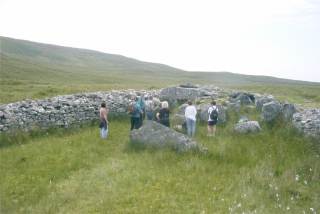 |
Clachan Mhor court cairnThis very impressive monument is a court cairn: a large, almost circular courtyard, open at one end, and extended at the other with a number of burial chambers in the walls and extension. This tomb dates from about 2500 B.C. and is the earliest of the tombs shown here. It was revealed when people were cutting turf: the walls have been partially rebuilt. Note the bog cotton in the front right of the picture.
|
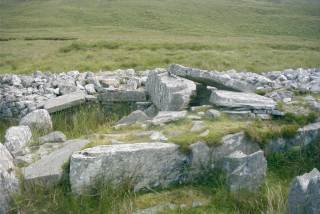 |
Clachan Mhor burial chamberA closer view of some of the actual burial chambers in the court cairn. There are at least half-a-dozen.
|
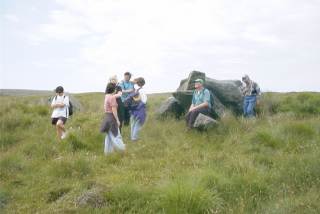 |
Portal tomb, Málainn MhóirAll the tombs in this section (including Clachan Mhor) are located within a mile or so of each other on the back road from Málainn Mhóir (Malin More) to An Charrig (Carrick), in easy walking distance of the Hotel. This one is a simple portal tomb, from about 2000 B.C.
|
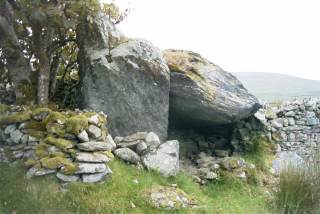 |
Portal tombNot all of the tombs stand in splendid isolation in the middle of a bog: this one has been incorporated as part of the wall of a small stone building. Another one in the area has been similarly used, and was (the story goes) actually lived in by a family who had been evicted at the time of the Famine.
|
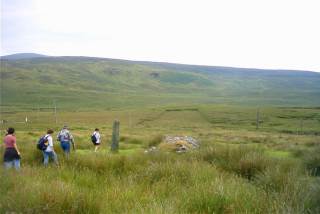 |
Standing stoneIn addition to the various large tombs, there are a number of simple standing stones. This one also has a burial mound nearby. The lines where the turf has been cut are clearly visible in the distance.
|
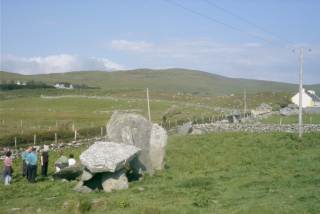 |
Row of portal tombsUsually the tombs stand by themselves. Here is a unique grouping with six portal tombs standing in a line within a couple of hundred yards of each other. one of them is little more than a small pile of stones now, but the others are very impressive. Four are visible in the photo.
|
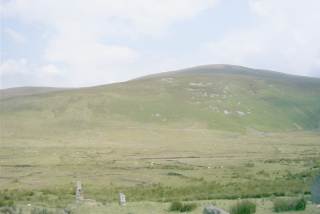 |
Neolithic fieldsThe land here used to be forested, but neolithic men started to clear it and practice agriculture. They built rectangular stone-walled fields, presumably as animal enclosures, and several of these are visible here along the bottom slopes of the hill, revealed when the turf was cut. Nearby there are the remains of a circular stone walled enclosure, where the people lived. Approx 2,500 B.C.
|
And now on to the Christian remains: most of these are associated with Columb Cille (St.Columba) who evangelised the area in the sixth century A.D.
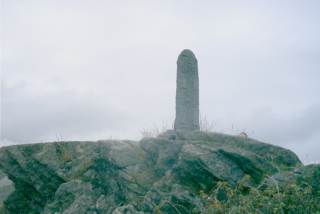 |
Turas stoneThe turas is a pilgrimage performed annually on 9th June. Starting at midnight pilgrims (ideally bare-footed) walk round the fifteen stations of the turas, saying various prayers as they go. Whilst some of the stations are directly associated with Columb Cille (like his chapel), many of them are pre-Christian standing stones and tombs, which were 'adapted'. This example is a standing stone, which has had beautiful celtic crosses inscribed on it.
|
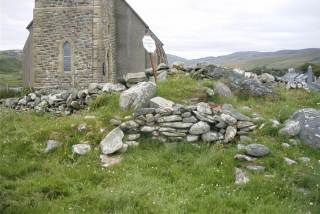 |
Turas AltarAnother 'adapted' monument: an old burial mound that has had a rough stone altar built next to it where pilgrims kneel to pray during their tour. The Church of Ireland chapel is in the background.
|
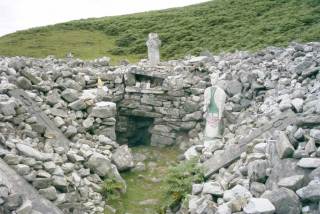 |
The Well of Columb CilleThis is the high point of the turas - the Well of St Columba. It is surrounded by a massive cairn (20+ metres long), built from stones carried up by the pilgrims on the turas, who take a drink from the well before continuing on their journey.
|
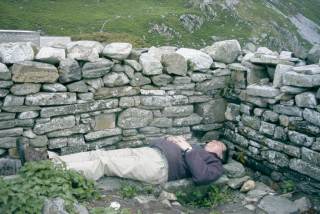 |
The bed of Columb CilleThis is a stone slab in the Chapel of Columb Cille, traditionally the bed of the saint. Pilgrims lie on the bed and turn over three times (personally, I'd turn over a lot more than three times a night if I had a stone bed - although it's surprisingly comfortable. Turning is murder on the knees though). Traditionally clay taken from beneath the bed has curative properties. A few yards from the chapel is a wishing stone: stand on the stone facing west, and you can have three wishes.
|
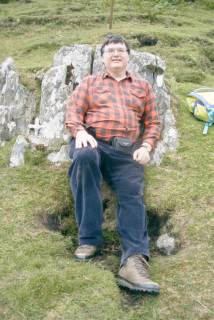 |
Columb Cille's seatThis chair-shaped stone is not far from the chapel and isn't part of the turas. Traditionally it is where Columba sat and meditated. I think he had the right idea: it really does have spectacular views across the glen.
|
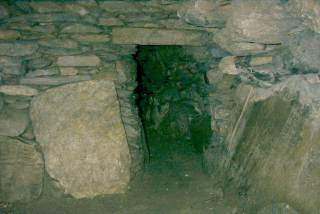 |
The SousterraineIn the churchyard of the Protestant church is a wonderful sous-terraine: an underground chamber lined in stone. Dated to the 6th-7th century, purpose unclear: possibly somewhere to hide, possibly a place to store food. A stone-lined shaft, like a well, goes down about 7 feet, and at the bottom opens out into an underground chamber, about 5-6 feet high, and perhaps 4x3 yards. There are two low narrow tunnels that run off it for some yards, but go nowhere in particular.
|
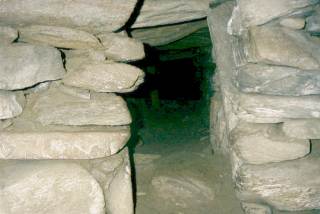 |
Another view of the sous-terraineThe other tunnel. Access is easy (just lift up the lid), but take a decent torch. The side tunnels are not recommended for tall people or claustrophobes. Apparently there are some inscriptions on some of the stones down the tunnel - I didn't get that far.
|
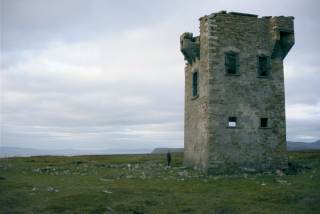 |
The signal towerThis and its companions have been mentioned before. Built at the time of the Napoleonic wars to watch out for invading French ships, they formed a chain around the coast. Each one was visible from the one on either side (assuming the weather was clear). This one is about 750 ft. up, and has great views. It must have been horrible to be stationed up there in winter, though!
|














